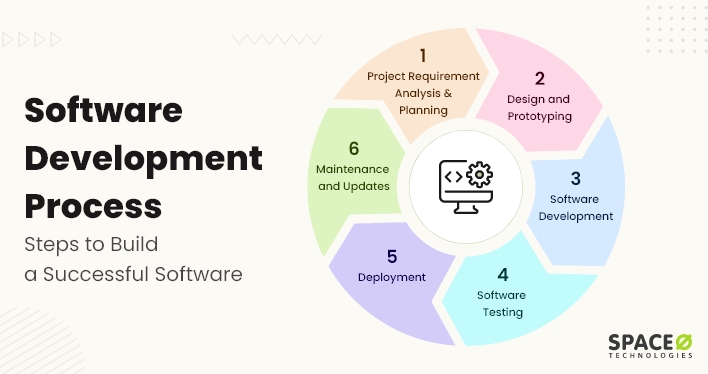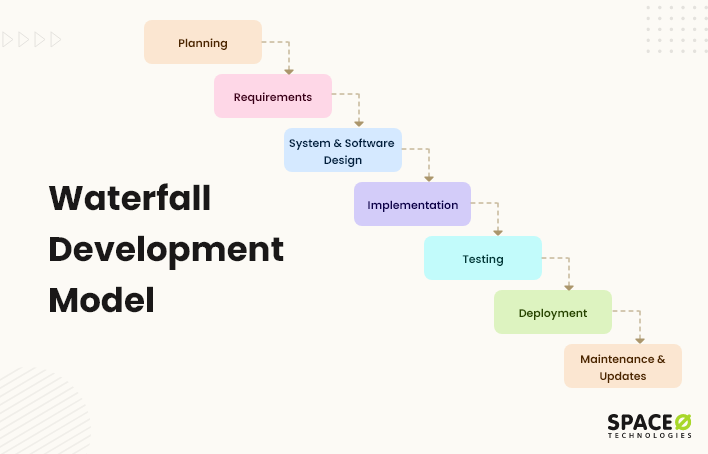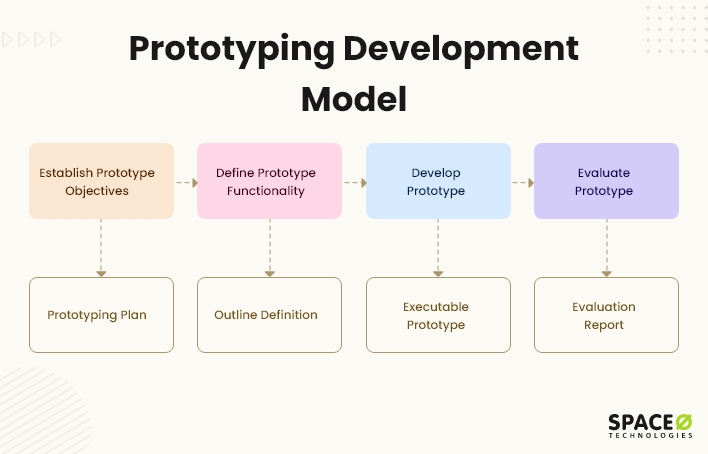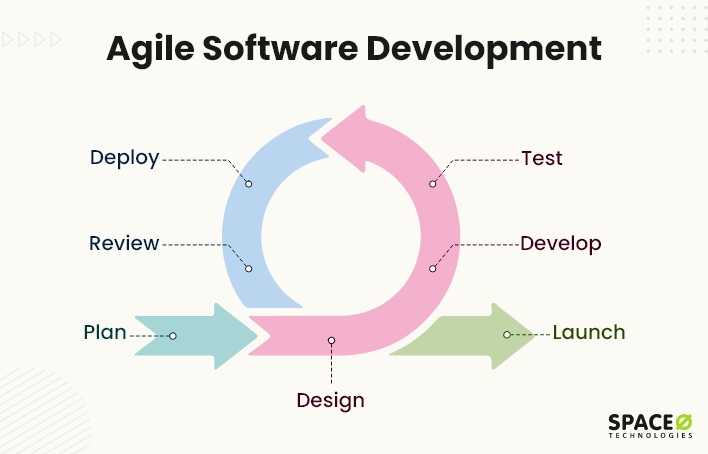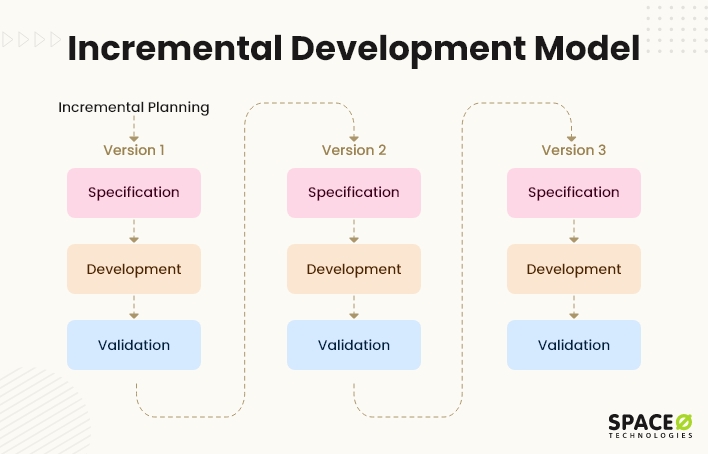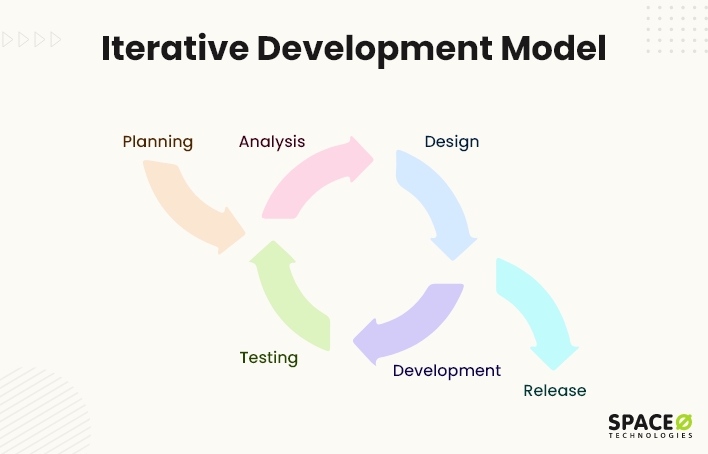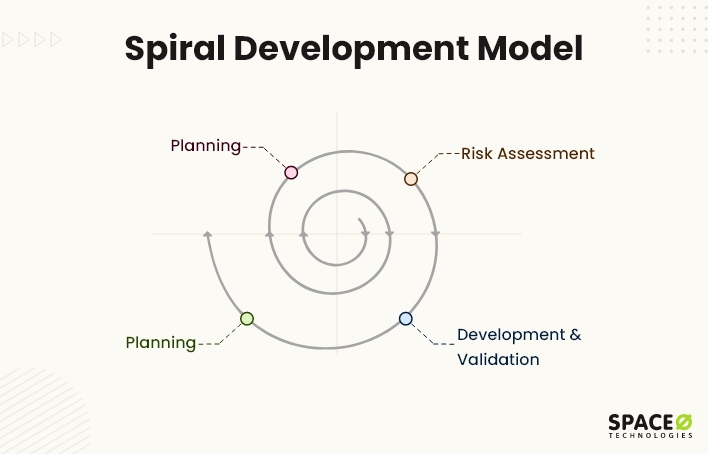The software development process includes these 6 core stages:
- Requirement analysis and resource planning
- Design and prototype to define the complete workflow
- Software development
- Software testing
- Software deployment
- Maintaining and updating a software
Being a leading software development service provider, we will explain each of these agile software development stages in detail. Along with the process, we will also learn 8 different software development processes that you must know.
Let’s get started.
What is SDLC (Software Development Life Cycle)?
The aim of SDLC is to build exceptional software that surpasses clients’ expectations and demands.
However, in order to understand SDLC, let’s first understand what is the software development process.
The software development process is a structured process to enhance and build products, projects, and designs together.
Once, you understand the exact meaning of custom software development, it will be easier for you to understand the meaning of SDLC.
In the following table, we have briefly explained the stages of the software development lifecycle to help you understand the overall software development steps and process.
| Step | Stage | Overview of a Stage | Expected Outcome |
|---|---|---|---|
| 1 | Requirement Analysis & Resource Planning | Ensures alignment with client needs and constraints. | Clear understanding of project scope |
| 2 | Design & Prototype Workflow | Establishes the blueprint for development. | Visual representation of software structure |
| 3 | Initiate Development with Complete Requirements | Ensures accurate implementation of specifications. | Functional software in development |
| 4 | Testing Phase Evaluation | Identifies and resolves defects. | Identified bugs and issues resolved |
| 5 | Post-Testing Deployment | Makes the software available to end-users. | Software accessible to intended audience |
| 6 | Continuous Maintenance & Updates | Sustains software performance and relevance. | Optimized software with enhanced features |
The software industry uses SDLC as it helps to produce high-quality software to meet customer expectations and smoothen the software creation process to complete software development within the given cost and timeline.
6 Stages of Software Development Process
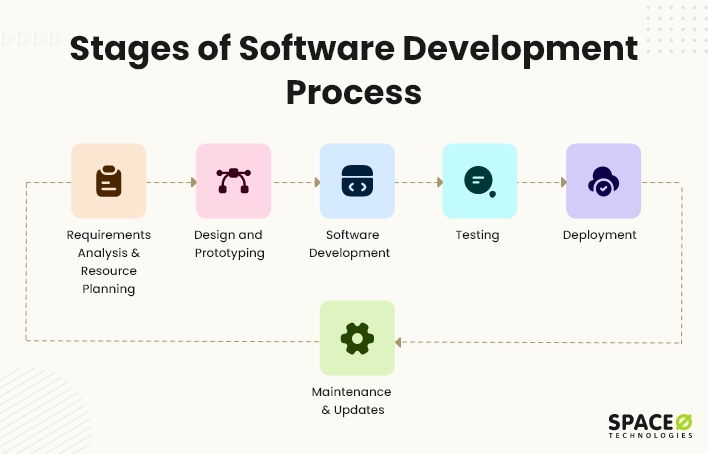
The following section shows the steps involved in software development.
Perform Requirement Analysis and Resource Planning
Planning is the crucial stage of software development. Being a project manager, you might have done a requirement analysis of your project, but you are going to need software engineering experts to create a software development plan for your project.
You need to analyze if the software, you are planning to develop, aligns with your business or personal goals. This is a requirements analysis. The purpose of any software is to make tasks easier. So, you must check which tasks you are trying to optimize and what are the benefits of creating custom software.
After this, you need to allocate resources for the software development process. You need to decide what kind of resources you will need in order to complete it. You can plan the number of project managers, software engineers, designers, tools, and technologies required for the project. Then, you need to create a flexible yet justifiable budget.
Design and Prototype to Define the Complete Workflow
After the analysis and planning part is over, it is time to start creating a software architecture for the product. This architecture or design will define the complete software development workflow. In terms of software, the design doesn’t only have to do about the look but also with the overall functioning and user experience of the software.
You can play an important part in the design process as you need to explain to the software designers what is that you want from the program. You can define how the users will interact with the software application/product. The designers will design simple wireframes to show these interactions using various tools like Adobe and InVision. If needed, you can also have complete prototypes that display each and every functionality of the product.
In this stage, you can check if there are any drawbacks or lack of features. You can easily make changes in this stage and start with development when everything is finalized.
Start Software Development After Receiving Complete Requirements
Development in the software process only begins when you are completely sure of the requirements and onboard with the design and features. The development team starts working on the development of a program by writing the necessary code.
Now, the development is carried out in different manners based on the type of software requirements. You will understand it in the software development life cycle models section below.
This is the riskiest phase of the software development process. However, being an experienced software development company, we easily understand the requirements and develop a product up to the expectations.
Check the Entire Working of Software in Testing Phase
This is actually a continuous process of software development, and testing is performed alongside development. Testing is done to check the functionality, usability, and stability of the product under the rapid development process.
We have a team of quality assurance testers or QA testers. This team tests every piece of code created by the software development team. This is done both manually as well with automated tools to find out if there are any bugs or glitches.
Our comprehensive approach to software testing has been recognized by industry experts. Recently, Designrush, a renowned platform for connecting businesses with top agencies, featured insights from our Director of Operations, Mr. Bhaval Patel, on their blog.
Mr. Bhaval highlighted our rigorous testing cycle, stating,
“At Space-O Technologies, we have a comprehensive software testing cycle incorporating JIRA, Selenium, and AWS. Our dedicated QA team conducts functional, security (with ZAP), usability (using Hotjar), performance, and cross-browser tests. Emphasizing thorough testing with tools like JMeter, Calabash, and Ranorex, we strive to deliver top-quality software to our clients around the globe.”Now let’s learn about the 4 types of testing methods we apply for error-free software development.
Software Testing Types Description Performance Testing In performance testing, the tester will check stability and response time by applying load. Performance testing is done using Loader.IO, JMeter, and LoadRunner. Security Testing The main purpose of security testing is to verify how software, app, or website is completely secure from external and internal threats. This testing method is performed to ensure the security of softwares. Unit Testing In unit testing, the testing is performed on an individual unit. Most developers utilize test automation tools such as NUnit, Xunit, and JUnit for test execution. Usability Testing Usability testing examines an application’s appearance, feel, and user-friendliness from the perspective of the user. Later, bugs are fixed by changing or adding new code to the original code. We make sure that your final product runs smoothly on the preferred devices and has all the required features and functionalities as discussed.
Deploy the Software Once the Testing is Completed
The software deployment process is the crucial stage in the software development life cycle. After coding and testing are done, the next development phase is to deploy your software on the necessary servers and devices. This is only done after you have approved the product functionality and the stability of the product is proven.
Many times, the product is given an Alpha release. A small bunch of users use the product and give their feedback. After analyzing the feedback, modifications are made to the software and then released as a Beta release. Now, more users have access to the software program.
Consistently Maintain and Update Your Software
As described earlier, software development is a cycle. It is an iterative process of software development. After launching the product, the process is not complete. You need to keep a track of software maintenance and keep upgrading it. You need to consistently monitor software development and suggest changes whenever required.
This is done because technology keeps advancing and in order to keep up with these changes, the software products are needed to be updated. As time passes, users have different requirements that are uncovered. Further, user feedback also plays an important role in devising future updates for any software product.
Finally, we also create software that is easily scalable for future scale-ups or scale-downs according to the changing trends and requirements. Check this guide and learn how we create the software from scratch.
Want to Hire a Software Developer?
Hire a team of the best developers based on your custom requirements.

So far, we have answered, “What are the steps involved in software developmeny?” Now, we will now talk about different software development process models that you can choose from, based on your requirements.
8 Best Software Development Methodologies
Further, we will discuss and learn about these 8 best software development methodologies.
| Sr. No | Methodology | Suitable For | Advantages |
|---|---|---|---|
| 1 | Waterfall Model | Projects with well-defined requirements and stable scope | Clear project milestones, easy to manage |
| 2 | Prototyping Development Model | Projects where requirements are not well-understood | Early feedback, improved requirement understanding |
| 3 | Agile Software Development Model | Projects requiring flexibility and frequent iterations | Adaptability, quick response to changes |
| 4 | Incremental Development Model | Large-scale projects with long-term development goals | Early delivery of functionalities, risk mitigation |
| 5 | Iterative Development Model | Projects with evolving requirements and frequent feedback | Flexibility, improved stakeholder satisfaction |
| 6 | Spiral Model | High-risk projects requiring constant risk assessment | Early risk identification, adaptability |
| 7 | V Model | Projects with a clear understanding of requirements | Strong emphasis on testing, clear deliverables |
| 8 | RAD Model | Time-sensitive projects with fixed deadlines | Faster development cycles, reduced time-to-market |
Waterfall Model
The Waterfall model is one of the oldest and most traditional software development methodologies. The waterfall approach is also called the linear sequential model or Classic life cycle model.

Imagine a staircase, while getting down, you need to cross each step without skipping. This is how the waterfall model works. Each stage of the software development process is crossed sequentially. However, in practicality, there are some overlaps. Testing and feedback are somewhat iterative in this model. This model is also used when an application lifecycle management framework is used in conjunction with the SDLC to build quality software. In order to go for this software development methodology framework, you need to be sure about every detail of your software project, delivery schedule, and delivery deadlines.
Phases of the Waterfall Model
- Planning
- Requirements
- Software system design
- Implementation
- Testing
- Product Release
- Maintenance/Updates
Who shall use the waterfall software development model?
Large organizations and government agencies that require documentation on all requirements and scope before a project starts. This is because the waterfall approach is fairly rigid. There is a little scope to make big changes in the software development process once it has started.Pros Cons - Requirements are fixed
- The project doesn’t derail from the schedule
- This approach lacks flexibility
- Longer delivery time
Prototyping Development Model
Well, the name couldn’t have been more apt for this model of the software development process. The project team creates a small prototype of the final software for the users. This version is used to get feedback for the users and also check the usability and feasibility of the design.
If there are any issues that come into the light while using the prototype, they are noted down and fixed. Such issues do not make it to the final software product.

Such a method is used when you are not sure of what your users might like or not like. This gives the software developers a chance to perform a risk analysis before putting the original product out in the market. In prototyping, you are involved throughout the development and design process. This way, you will clearly understand the requirements of your users from the product.
Further, the prototypes are meant to be discarded once they have been tested. Yet, it is not uncommon when a prototype is upgraded after testing and developed into the final product.
Phases of Prototyping
- Establish objectives
- Define prototype functionality
- Develop the prototype
- Evaluate the prototype
Who can use it?
Prototyping is an approach that can be a part of any of the mentioned methodologies. You can use it if you want to create prototypes before finalizing the final product.Pros Cons - You can quickly detect errors
- You can create better solutions with user feedback
- The complexity of the process might increase
- The process may become time-consuming
Agile Software Development Model
The agile approach is the most popular software development methodology (also known as system development methodology). Generally, the top software development outsourcing companies follow this agile software development model. This is due to the fact that it is highly dynamic and iterative, which leads to fewer errors in the final software product. In fact, according to a survey by GoodFirms, Agile has been considered as the aptest development method. In fact, more than 61% of projects are done using this methodology.
This method is the exact opposite of waterfall development. Agile means fast and flexible and the methodology takes on its name completely. You or development team can easily make changes to your initial plans. In fact, we use this methodology for almost all projects. According to Harvard Dataverse, Agile software development has various implications in AI product development as well as Big Data analysis.

In agile development, you do not need a complete list of requirements. You can explore and find out more as you go along. You do not have to develop all the functionalities at once. You can develop some features and check the user response before taking a step ahead. This will save you from putting too much effort that might go to waste.
Agile processes follow a flexible and iterative approach, in which there is constant user involvement in order to understand their mindset, carry out a project risk assessment, and bring about process improvement. Scrum, Crystal, Agile Modeling (AM), and Extreme Programming (XP) are some examples of different agile methods.
Phases of Agile Software Development
- Requirements
- Design
- Development
- Testing
- Deployment
- Feedback and validation
- Plan next sprint
Who shall use agile software development?
As the development cycle is flexible, the budget and timeline also need to be somewhat flexible. If you have a tight budget and timeline, this model is not for you. The projects that require frequent updates can use this methodologyPros Cons - The is one of the most flexible software development models
- The products get to the market in lesser time
- The changes can be fairly unpredictable
- There can be difficulty in scaling
Incremental Development Model
The idea behind the incremental development model is to develop small pieces of software and testing them on the users for feedback. You can think of it as a series of mini-waterfall development. All phases of the waterfall model are completed before moving on to the next increment.

Here, each increment is a new feature or functionality that is added to the product. It is tested, validated, and then moved to another increment. Have you heard about MVP in software development? It is the Minimal Viable Product that has only the core functionality and upgraded after getting feedback from users.
Phases of Incremental Model
- Specifications
- Development
- Validation
Who can use it?
If you need more flexibility than the waterfall methodology, then the incremental approach is for you. The incremental method will tell you the user’s perspective on the core feature of the product. Do not use it if you have a long-term rigid technology plan.Pros Cons - This model is less expensive compared to others
- Errors are easily identified
- The process can be time-consuming
- It requires planning even for future updates
Iterative Development Model
In the iterative software development model, you develop one version of your product with a version of all the features and functionalities. In the next step, you release this version, say V1.0, get feedback from the users, and then upgrade the features.

With each version, your software gets evolved and gets one step closer to the final version. Many intermediate versions are developed by following the same process again and again. This is the reason this methodology is called an iterative model of software development. You will basically understand and get an early look at what the final version might look like. This helps you get better customer feedback.
Phases of Iterative Model
- Analysis
- Design
- Development
- Testing
- Repeat (Till you get the final version)
- Release
Who can use it?
As this model is more flexible than the waterfall method, you can go for it if your requirements are flexible and you want to explore the possible outcomes of your software. You should go for this method if you are ready to do heavy planning and architecture-building beforehand. It is ideal for big projects.Pros Cons - There is more focus on design rather than documentation
- There is a reduction in operating time
- There might be more expenditure on resources
- The successive stages are rigid with no overlaps
Spiral Model
You can call the Spiral model as a risk-driven model in which the process is radially curling instead of sequential. It has the best features of waterfall and prototyping methods, along with a new element of risk assessment. This method focusses on testing and risk assessment with the incremental nature of Iterative, Incremental, and Agile.

The first spiral software development process is about planning for an iteration or a milestone. The next step is to perform an in-depth risk analysis to find out which areas are at risk and where the errors are. After this, you work on the prototype to correct the errors and get user feedback again. This becomes one milestone. After each step, the scope of the software projects expands spirally, hence the name. You start planning again, get feedback, correct mistakes, complete a milestone, expand the scope, and move ahead.
Phases of the Spiral Model
- Planning
- Risk Assessment
- Development and validation
- Evaluate results
- Plan the next loop
Who can use it?
Not most people. This methodology is only for the people who are working on a large project with little to no scope for any mistakes. This process is time-consuming as well as expensive. You need to be completely sure of your requirements and have a large budget to go for this model of development.Pros Cons - It is a highly flexible model
- Perfect for large complex projects
- Extremely costly in the practical sense
- Not appropriate for small projects
V Model
The “V Model” is an extension of the waterfall model we discussed above and in this software development process each development stage has a corresponding phase of testing. This helps to ensure that defects are identified and addressed as early as possible, which can help to reduce the overall cost and development timeline to deliver the software.
Pros Cons - It allows for quick bug detection and refinement
- It improves communication due to having a structured approach.
- Successive testing makes this model inflexible for changes or new requirements
- Constant testing leads to longer development time & less customer involvement
RAD Model
The Rapid Application Development (RAD) model is a software development process that prioritizes speed and efficiency. It divides the development process into iterations, each focusing on a different aspect of the software and aiming to produce a working prototype that can be refined through testing and feedback. The RAD model is ideal for projects where time is of the essence and business requirements are not clearly defined, and it also allows for regular customer input to ensure the final product meets their requirements.
Pros Cons - It allows for fast and flexible software developmen
- It encourages customer involvement & regular feedback
- Lack of well-defined requirements can lead to a lack of structure in the development process
- Prototyping focus hinders thorough testing before deployment
There are a lot of coding languages that are used in software development. However, some languages are preferred more over others due to their ease of use or functionality.
Want to Develop Enterprise Software for Your Business?
Having developed more than 4400 projects for businesses we will analyze your requirement and develop fully functional software for your business.
It is now time to find out the answers to the most commonly asked questions.
FAQ About Software Development Process
What is PDLC (Product Development Lifecycle)?
The entire process of planning, developing, and introducing a new product into the market is called Product Development Lifecycle. It has the following 5 steps:
- Product Ideation
- Product Design and Architecture
- Product Development
- Product Launch
- Product Realization and Future Upgrades
How SDLC can be useful for any system development?
SDLC helps in breaking down the entire software development process in small parts. Smaller parts are easy to evaluate and help the software engineering experts to work smoothly. Project management also becomes easier as each stage can be focussed individually as well as concurrently.
What is software design process?
The software design process involves creating a design document that outlines the architecture, components, modules, interfaces, and data for a software system based on the requirements listed in the Software Requirements Specification (SRS) document. This process ensures that the software system is well-structured, easy to maintain, and meets the needs of the users.
In layman’s terms, the software design process is the first step in the software development process and focuses on the planning and design aspects of software creation, whereas the software development process covers the entire process of creating a software product.
Should I outsource my software development project?
Well, it really depends on the type of software. Outsourcing is the most efficient way of getting your software developed. You save resources as well as time if you go for outsourcing. When you go for in-house development, you have to hire project managers, software developers, designers with proper skills, manage their payroll, sick-leaves, holidays, infrastructure maintenance as well as insurance.
On the other hand, when you outsource developers, you need to care only about your project management. The development company will take care of every other aspect, including helping you with managing the entire process.
If you are confused about whether you should go for outsourcing or in-house development, feel free to tell us a bit about your project. We will guide you further.
How do I hire a software developer?
If you want to hire software developers, you just need to follow these simple steps:
- Step 1: Contact us
- Step 2: Discuss your project with us
- Step 3: We will give a list of candidates that you can choose from
- Step 4: Interview these candidates and choose the best
- Step 5: Hire the software developers of your choice and start the process
Looking for Enterprise Software Development for Your Business?
You have understood the fundamentals of software creation and learned the concepts such as SDLC and the phases of the software development process in simple terms. By following this guide, it will be easier for you to decide which software development methodology will suit your project requirements. However, in case of any questions regarding software development processes, or how to find and hire a software development company, reach out to us.
We are a leading software development company with experience in developing over 4400 projects. Our main goal is to partner with top enterprise software development companies and help them accelerate their business by meeting their mobile app development goals.
